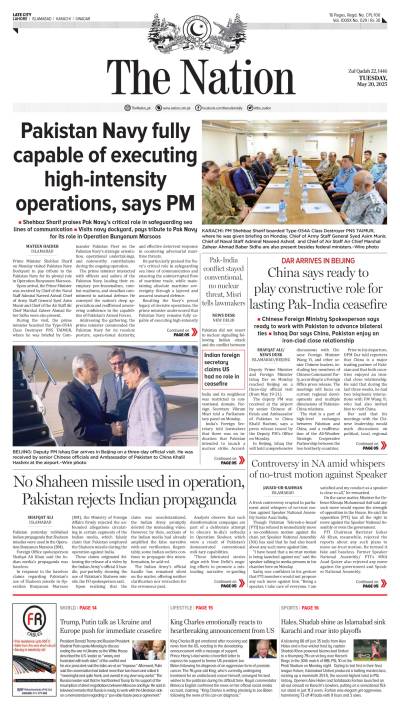LAHORE - The heavy axle loading is the key factor in rapid roads deterioration in Pakistan, causing road sector inefficiencies leading to a total annual loss of Rs240 billion or 6.8pc of the GDP. The loss is further accelerated by the fact that truck drivers and owners consider overloading as a profitable practice unaware of the adverse effects of this practice, said Director Highway, Research & Training Centre.
Dr Shafiq Ahmad further said, “In Pakistan, presently there are around 150,000 registered commercial trucks (3% of total vehicles) plying on our roads, including 67pc 2 & 3 axle rigid trucks, 8pc articulated trucks and 25pc multi-axles trucks. Around 90pc commercial vehicles carry more than the allowed axle load on our roads.” He was delivering a lecture on the impact of heavy axle loading on pavement performance on national highways network, organized by Pakistan Engineering Congress. Pakistan Engineering Congress president Ch Ghulam Hussain also addressed the seminar.
“Since there is no adequate truck manufacturing industry in Pakistan, types and makes of these trucks varied. Bodies are mostly manufactured in Pakistan by local industry not following proper dimensions. Bed Ford (53%), Hino (23%), Nissan (16%), Isuzu (5%), other (3%) are common types of trucks,” he informed.
According to a study carried out by NHA, there is a trend in the commercial market to use multi axle trucks instead of 2-axle. In 1982, share of 2-axle was 96.5% that reduced to 69% in 1995, whereas share of multi axle trucks increased from 4% in 1982 to 31% in 1995.
Axle load study conducted in 1995 indicated that 88% of trucks are loaded above the designed limits of 8.2 tons and 43% above the axle load limits of 12 tons. The prime reasons for the overloading are the dominant presence of 2-axle trucks i.e. 69% in the overall truck fleet presently plying on our national highways. Various studies indicated that 2 axle trucks cause most of the damage to pavement structure because of load distribution mainly on rear axle.
Technically speaking damage of road by standard axle (8.2 tons) is one and any increase in load on an axle increase by a power of 4.5. Studies revealed that almost 100% of the tyres are inflated in excess and are mostly as high as 160 PSI against permissible design limits of 100 PSI.
Analysis of variance and comparison of actual and designed truck factor were performed to identify the most damaging axle truck type. It was found that axle truck type 3 (single/tandem axle) is most damaging among all truck types. The actual truck factor for axle truck type 3 is 6.4 times greater than design truck factor. It was also observed that damaging effect of various types of trucks was very severe and quite high.
Officials said that the National Highway Authority (NHA) and National Highways and Motorways Police (NH&MP) have been taking several steps to control overloading of vehicles on motorways and highways in the country.
The National Highway Safety Ordinance (NHSO) 2000 was promulgated to control overloading on national highways. The establishment of weigh stations at 94 locations on motorways and highways was being finalized and it was being ensured that overloaded trucks were fined as per National Highways Safety Ordinance (NHSO) 2000.
According to experts, assessment of road damages in terms of financial losses caused by overloading is a very complex and non-tangible exercise in presence of multiple factors attributed to failure of pavements in Pakistan like use of substandard construction materials and construction methods, inadequate compaction, improper drainage system, type and condition of vehicles and number of passes of axle load.
Wednesday, May 21, 2025
Trucks overloading: Road sector inefficiency causing Rs240b loss

5:43 PM | May 20, 2025
PM directs zero tolerance against tax evasion
May 21, 2025
Dozens dead by Israeli strikes on Gaza
May 21, 2025
Shujaat felicitates Field Marshal Syed Asim Munir
May 21, 2025
-
Lahore emerges among safest global cities in Numbeo 2025 index
-
Lahore emerges among safest global cities in Numbeo 2025 index
-
India’s suspension of Indus Water Treaty legally baseless
-
Seventh polio case reported in Pakistan amid nationwide vaccination drive
-
Pakistan reports sixth polio case of 2025
-
PTA begins issuing VPN licences to regulate usage
The Wider War
May 20, 2025
Margalla on Fire
May 20, 2025
Defeated and Depressed
May 20, 2025
Regional Reset
May 19, 2025
Peak Potential
May 19, 2025
Golf or Water
May 21, 2025
Performing CPR
May 21, 2025
Lack of Sign Language Teaching
May 21, 2025
State of War & Public Awareness
May 21, 2025
Indian Attack
May 21, 2025
ePaper - Nawaiwaqt
Nawaiwaqt Group | Copyright © 2025





